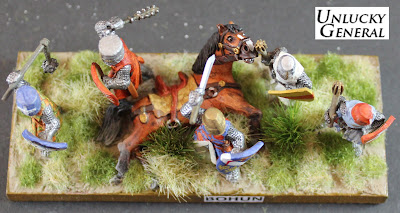Lewes and Evesham 1264-65: A Partial Review
Lewes And Evesham 1264-65 (Simon de Montfort and the Barons' War) by Richard Brooks and illustrated by Graham Turner is recently released (2015) Osprey Publishing account of these campaigns and battles, referenced as Campaign 285.
Eagerly awaited and immediately consumed (the Lewes part) I can now report on what it is and what it is not. Running to 96 printed pages, 40 of those pages are devoted to the Lewes campaign of 1264. Accompanied by 3 bespoke maps, two 3-dimensional 'bird's-eye-view' map illustrations and two of Turner's illustrations Including the cover above) it is a concise, detailed synopsis of events. This is also an invaluable must-have first stop. I say first stop because it many ways it is an updated rehash of much which is already known about this battle, limited to the confines of the Osprey Publishing approach.
Once the preceding events of the capture of Northhampton and the siege of Rochester are dispensed with, the Lewes narrative is reduced to 26 pages (graphics and text). What follows then are treatments on Lewes and it's Surroundings, Prelude to Battle, The Battlefield, Numbers and Dispositions and then a 14 page description of The Wretched Battle of Lewes which runs to only just over four pages of text - wretched indeed (sorry ... couldn't help it). If I might get my criticisms out of the way: Turner's two illustrations are nice depictions of soldiers of the period but they add nothing to any graphic depiction of the battle or how it may have looked or unfolded. I do not find them particularly useful.
What this edition is not is a detailed analysis or discussion of key events in the battle. Some brief comment is contained to be sure, but several important questions are not posed - even if answers are not to be found. The immediacy of the collapse of the London rebel left flank before Prince Edward's cavalry charge is uncritically repeated. On this particular aspect as well as other matters, the biased or inexpert medieval chronicler's are unevenly relied upon throughout as far as I can see.
Some time (as always) is dedicated to placement of this battle with attention paid to the naming and location of Snelling's Mill as a key reference point. Nevertheless, Brooks regrettably has no more access to a comprehensive geological battlefield survey than the authors which come before him as to date, none exists. Until that time it remains an academic exercise regardless of how compelling some of his arguments might be. The divergent propositions on this particular point made previously also have merit and are put forward with equal confidence.
For elevating this incredibly significant battle into a more general awareness care of the Osprey reach, I applaud Richard Brooks for attending to the second Barons' War and I'm glad to have added this volume to my collection.
Eagerly awaited and immediately consumed (the Lewes part) I can now report on what it is and what it is not. Running to 96 printed pages, 40 of those pages are devoted to the Lewes campaign of 1264. Accompanied by 3 bespoke maps, two 3-dimensional 'bird's-eye-view' map illustrations and two of Turner's illustrations Including the cover above) it is a concise, detailed synopsis of events. This is also an invaluable must-have first stop. I say first stop because it many ways it is an updated rehash of much which is already known about this battle, limited to the confines of the Osprey Publishing approach.
Once the preceding events of the capture of Northhampton and the siege of Rochester are dispensed with, the Lewes narrative is reduced to 26 pages (graphics and text). What follows then are treatments on Lewes and it's Surroundings, Prelude to Battle, The Battlefield, Numbers and Dispositions and then a 14 page description of The Wretched Battle of Lewes which runs to only just over four pages of text - wretched indeed (sorry ... couldn't help it). If I might get my criticisms out of the way: Turner's two illustrations are nice depictions of soldiers of the period but they add nothing to any graphic depiction of the battle or how it may have looked or unfolded. I do not find them particularly useful.
What this edition is not is a detailed analysis or discussion of key events in the battle. Some brief comment is contained to be sure, but several important questions are not posed - even if answers are not to be found. The immediacy of the collapse of the London rebel left flank before Prince Edward's cavalry charge is uncritically repeated. On this particular aspect as well as other matters, the biased or inexpert medieval chronicler's are unevenly relied upon throughout as far as I can see.
Some time (as always) is dedicated to placement of this battle with attention paid to the naming and location of Snelling's Mill as a key reference point. Nevertheless, Brooks regrettably has no more access to a comprehensive geological battlefield survey than the authors which come before him as to date, none exists. Until that time it remains an academic exercise regardless of how compelling some of his arguments might be. The divergent propositions on this particular point made previously also have merit and are put forward with equal confidence.
For elevating this incredibly significant battle into a more general awareness care of the Osprey reach, I applaud Richard Brooks for attending to the second Barons' War and I'm glad to have added this volume to my collection.




Comments